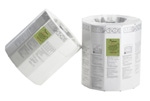January 30, 2014


Wine kegs
In a recent issue of the trade publication Wines & Vines, the editor drew a parallel between politics and packaging: wineries are either liberal or conservative. The conservatives think inside the box, the liberals try anything.
At Clayhouse Winery in Paso Robles, California, winemaker Blake Kuhn uses screw tops ("why wouldn't you?" he asks) and is now filling more and more kegs, in addition to traditional glass bottles. "Screw tops ensure that the wine a consumer pulls of the shelf is exactly the way I wanted it when it left the winery; it's about providing a quality bottle of wine," says Kuhn.
As for kegs, Kuhn says Clayhouse has plenty of restaurant accounts that would rather buy a 20 liter keg of Adobe Red wine than individual bottles. And for wines poured by the glass, buying the wine in recyclable kegs saves restaurants money.
It's less about thinking outside the box than it is about giving the customers what they want.
In fact, Clayhouse regularly considers all sorts of packaging options, including stainless steel kegs, pouches, cartons, plastic bottles, and bag-in-box.
Kuhn buys kegs from KeyKeg. They're fully recyclable, saving the winery the cost of returns, and they weigh less than glass bottles, so shipping costs and the carbon footprint are both smaller than shipping glass.
"I think screw top closures (instead of cork) have opened everyone's eyes to even more alternatives," says Kuhn, "and now wineries are using bag-in-box, plastic, and foil pouches as well as kegs. It's all about packing that maintains wine quality and delivers whatever the customer wants."
Monterey winery Mer Soleil even bottles their unoaked Chardonnay in a ceramic bottle.
Kuhn believes packaging trends show how willing younger wine consumers are to try new things, and how wineries are willing to offer alternatives. Kuhn's Adobe Red competes in the hot blended red wine category, where producers sometimes use a "kitchen sink" approach to get wine on the shelf faster.
Not Kuhn: "We're very deliberate," he says. "We're not interested in just blending a bunch of leftover wines together. We actually select specific sections of our vineyard before harvest to make our Adobe Red, and we make it dry, different than most of our competitors who are making sweet red blends."
The bottom line: Wineries are looking for packaging alternatives and blending all sorts of grape varieties in order to give their customers what they want, in the way they want it, with the best wine quality and price combinations.
About the Author(s)
You May Also Like


